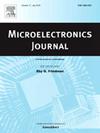Optimized design of UTB SOI MOSFET and connections for 2.45 G weak energy density harvesting
IF 1.9
3区 工程技术
Q3 ENGINEERING, ELECTRICAL & ELECTRONIC
引用次数: 0
Abstract
This paper presents and optimizes for the first time the design of UTB SOI MOSFET and its connection method for 2.45 GHz weak energy density harvesting, and optimizes the device structure parameters by Sentaurus TCAD software, so that the device exhibits the desired characteristics of high forward bias current and low reverse leakage current. The new connection method utilizes the device's back bias regulated threshold voltage to enable the device's dual gates to simultaneously control the channel current, resulting in a highly efficient RF-DC rectifier at a modest energy density of 2.45 GHz.The Sentaurus Mixmode circuit mixing simulation module shows that in a half-wave rectifier circuit with loads of 0.1 pF and 20 kΩ, the single-tube energy conversion efficiencies of the new device reach 9.95 % and 19.27 % at input energies of −16 and −10 dBm, respectively, which are 2.73 and 2.48 times that of a silicon-based MOSFET under the same conditions.
求助全文
约1分钟内获得全文
求助全文
来源期刊

Microelectronics Journal
工程技术-工程:电子与电气
CiteScore
4.00
自引率
27.30%
发文量
222
审稿时长
43 days
期刊介绍:
Published since 1969, the Microelectronics Journal is an international forum for the dissemination of research and applications of microelectronic systems, circuits, and emerging technologies. Papers published in the Microelectronics Journal have undergone peer review to ensure originality, relevance, and timeliness. The journal thus provides a worldwide, regular, and comprehensive update on microelectronic circuits and systems.
The Microelectronics Journal invites papers describing significant research and applications in all of the areas listed below. Comprehensive review/survey papers covering recent developments will also be considered. The Microelectronics Journal covers circuits and systems. This topic includes but is not limited to: Analog, digital, mixed, and RF circuits and related design methodologies; Logic, architectural, and system level synthesis; Testing, design for testability, built-in self-test; Area, power, and thermal analysis and design; Mixed-domain simulation and design; Embedded systems; Non-von Neumann computing and related technologies and circuits; Design and test of high complexity systems integration; SoC, NoC, SIP, and NIP design and test; 3-D integration design and analysis; Emerging device technologies and circuits, such as FinFETs, SETs, spintronics, SFQ, MTJ, etc.
Application aspects such as signal and image processing including circuits for cryptography, sensors, and actuators including sensor networks, reliability and quality issues, and economic models are also welcome.
 求助内容:
求助内容: 应助结果提醒方式:
应助结果提醒方式:


